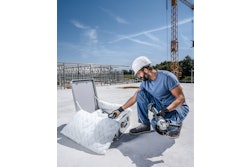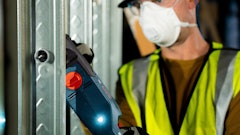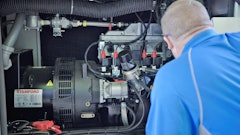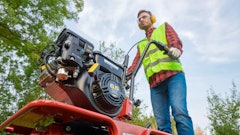
The Green Revolution rolls on. And while it may take another five to 10 years for battery-powered equipment to overtake gasoline or diesel equipment, renters realize its tremendous potential and search for batteries that offer solutions to today’s market conditions. That drives the demand for high-performing maintenance-free batteries. Here are ways to select the most suitable maintenance-free batteries for your applications that let you save time and money: two things that are always in short supply.
Corporate sustainability goals and noise and vibration issues are driving rental equipment companies and renters into battery-powered equipment. Further, corporate and governmental regulations continue to propel schools, stadiums, healthcare systems and many other users away from gasoline and diesel-powered equipment.
Indeed, analysts expect the rental industry to spawn the adoption of battery-powered equipment in construction and other sectors, with material handling and access equipment, golf and utility vehicles and floorcare machines leading the way. The growing use of battery-powered equipment dispels the myth of gasoline and diesel equipment superiority.
But labor shortages, rising wages and supply chain delays also affect users’ battery needs and make them keep their equipment longer and operate it more hours per day.
As a result, equipment rental companies and renters bypass flooded lead-acid batteries in favor of maintenance-free batteries to increase the return on their investments.
A buyer-beware market
The interest in battery-powered equipment has attracted new manufacturers, many of whom still need to perfect their manufacturing techniques and offer a limited portfolio. Despite their attractive prices, they don’t always deliver the quality products, services, safety and support rental equipment professionals require.
In this changing battery landscape, rental professionals need to follow advances in battery technology and do their due diligence before purchasing.
From Flooded to Sealed
For decades deep-cycle flooded lead-acid batteries were the go-to option for rental equipment companies. But their free-flowing electrolyte requires maintenance, employee training, and frequent replacements.
Although most manufacturers recommend that these batteries maintain a DoD of 50 percent, operators often use them in a partial state of charge (PSoC) in real-world applications. This causes sulfation, corrosion, and early failure. And they take eight to 12 hours to charge. However, they may be a good choice for users who want the lowest possible entry price and don’t mind the maintenance and employee training these batteries require.
Maintenance-fee battery options include standard absorbed glass mat (AGM), a premium AGM with carbon additives that outperforms standard AGM, and lithium-ion. Compare these technologies to select the most suitable battery for your application.
Road warrior: Standard AGM
When standard AGM sealed battery technology was introduced for military aircraft in 1985, power, weight, safety and reliability were paramount considerations.
Rather than free-flowing, the electrolyte in AGM batteries is immobilized between absorbed glass mats. This eliminates maintenance, watering and training and improves vibration resistance.
The least expensive of the maintenance-free batteries, standard AGM batteries experience lower internal resistance and generate less heat in the charge/discharge cycle than flooded batteries, increasing longevity. You can store and install them in any orientation, and they charge faster than flooded batteries.
While standard AGM batteries can withstand a DoD of up to 60 percent in most applications, they are not designed for opportunity charging or PSoC operation. They must be fully charged after each use to prevent damage.
Standard AGM batteries may be suitable if you want a low price point, serve renters who drive on bumpy or rough terrain, and use their equipment in cold to mild temperatures but not extreme heat.
Premium AGM with a carbon additive
Premium AGM batteries with carbon additives deliver all the benefits of standard AGM but also overcome real-world work situations in which batteries are often operated at lower than-recommended DoD. Premium AGM batteries safely handle discharges of about 80 percent, PSoC and opportunity charging.
Designed with a combination of advanced technologies, they feature different additives and upgrades, deliver two-to-three times the cycle life of standard AGM, and may work in scorching and freezing climates, depending on the manufacturer.
Do your due diligence
The longevity and performance of premium AGM batteries vary by manufacturer. Consider these factors when selecting them.
Several manufacturers make batteries with carbon additives that prevent sulfation and preserve the negative active material. To increase the return on your investment, look for options featuring technology that helps prevent the degradation of the positive active material as well. This further extends battery life.
Compare the cycle life of various models. The best delivers up to three times the cycle life of standard AGM and are validated at 1,200 cycles at 100 percent DoD. Most only double the cycle life of standard AGM.
To avoid downtime, make sure they deliver robust performance in extreme conditions and temperatures ranging from -40 degrees F to 160 degrees F.
And buy batteries tested to withstand long-term PSoC, again and again, to ensure high performance in the field, where it counts.
Premium AGM batteries are a good option if you are cost conscious, need to maintain performance in extremely cold or hot temperatures, need opportunity charging, and keep your equipment for three to five years and want to use the same batteries.
The batteries have plug-and-play compatibility with standard AGM chargers and algorithms and are 99 percent recyclable.
King of the road: Lithium ion
Groundbreaking lithium-ion batteries revolutionized energy storage. These maintenance-free powerhouses last up to 10 years, fully charge in four hours, and can generally discharge safely between 90 percent to 95 percent, giving them the most extended run times of any of the three options.
Each lithium-ion battery weighs about half as much as a flooded lead-acid battery, and you’ll need only two-three lithium compared to six to eight flooded lead-acid. This allows renters to carry more passengers or cargo. The batteries maintain consistent power regardless of the state of charge.
Moreover, these batteries deliver the lowest total cost of ownership (TCO) over their expected 10-year life. However, they carry the highest initial price, making them cost-prohibitive for some businesses. They are made from virgin materials, and their recyclability is limited.
Lithium-ion batteries can be a good choice if you keep your equipment for five years or longer, use the battery for 10 or more years, require the most extended possible run times, and shop based on TCO. They are also a good option for users who drive on hilly or rough terrain and need extra power to accelerate quickly and maintain speed and vibration resistance.
What to look for in lithium-ion batteries
The build quality and performance of lithium-ion batteries run the gamut from superb to so-so.
Consider the range when shopping for lithium-ion batteries, as it varies by model. The best deliver 45 miles to 60 miles on a single charge with a three-battery configuration, or 15 percent farther than other models.
Ask if the battery has been tested for off-road durability to automotive standards (SAE). This is especially important on rough and rocky construction sites.
Since safety is always a primary concern, look for a trusted brand with a stable lithium-iron-phosphate (LFP) formula. And ask if the battery features an intelligent battery management system with built-in redundancies against short circuits and overheating.
Cost of electric versus gas or diesel equipment
Battery-powered equipment generally costs more upfront than gas or diesel, but it cuts fuel costs and requires much less maintenance.
Further, the operating time of gas and diesel construction equipment is calculated by engine runtime. Many of those hours occur when the machine is idle, racking up thousands of hours on diesel equipment. With battery-powered equipment, the motor turns off when the operator stops working, so no idle hours accumulate. This further lowers operating and TCO and improves resale value.
Battery-powered equipment also helps users meet their environmental, social and corporate goals. You may also be eligible for federal and state tax credits, carbon credits, and offsets.
Final thoughts
To maximize your investment, partner with an established battery manufacturer offering a full product line, a comprehensive dealer and distribution network and an international customer support line staffed by battery experts.
Also, ask where their batteries are made. Companies with manufacturing facilities on several continents may help you avoid supply-chain problems.




















